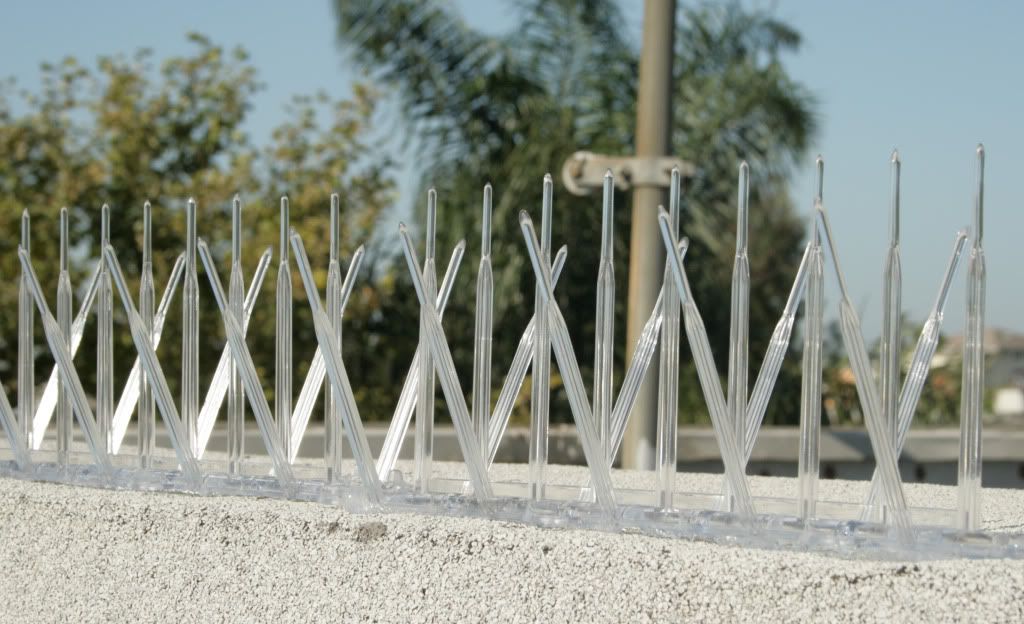You just painted your fence—all 150 feet of it. It looks beautiful, a gleaming testament to your hard work. But now the birds have come. Perching and preening and studying the lay of your backyard. And while they’re busy, they start to drop their loads, streaking your beautiful freshly painted fence with unsightly droppings for the world to see. You get out the garden hose and you attack. The birds flee and you wash and scrub until the streaks are almost gone. But you realize that they will be back. You can’t stand guard with a hose in your hand 24/7. The birds know that. And you know it. So being smarter than the birds, you arm yourself with the latest bird proofing devices man in his infinite wisdom has developed. The deterrents that ornithologists and commerce have teamed up to create. Your arsenal is thus:
Bird Spikes. Want to prevent large birds such as pigeons, crows or gulls from landing on your fence line? Bird Spikes are used to humanely prevent birds from landing by creating an un-even landing space. Birds know they can not get footing on the spikes, and will move on. Bird Spikes generally come in two foot sections and can be nailed, screwed, glued or tied down to most surfaces. The spikes are designed for outdoor use and are a permanent solution for preventing birds from landing.
Transparent Bird Gel. Spread this invisible gel on the top of your fence and birds will hate you for taking away their poop stand. Pest birds can’t stand to set foot on the sticky sensation on their feet and will move on to a more comfortable spot. Each tube of bird gel will treat an area approximately 10 feet long by 3 inches wide. The sticky gel stays sticky in temperatures from 15F to 200F, and one application usually lasts up to 6 months outdoors. The gel is easily applied using virtually any standard caulking gun. It’s perfect for deterring pigeons, sparrows, crows, gulls, starlings and many other species of birds. The gels are non-toxic to birds, so you won’t have to worry about violating any protective species ordinances. The only caveat is to not use gels where birds have been nesting.
Hawk Decoys. Quality construction and realism are the two key things to look for here. You want the decoy to last and you want pest birds to believe it’s real. You also want a Red Tailed Hawk decoy because most pest birds know that these predators hunt during the day (unlike owls who hunt for mice at night when birds are asleep). Always opt for the most realistic looking bird control decoy you can afford. The best decoys are made of heavy duty plastic and will be weather and water-resistant. They can be easily attached to fence posts. Some decoys even come with a bottom tab that lets you fill the inside of the hawk with sand. Doing this makes the decoy more stable. Better decoys include a convenient loop at the top so you can hang them from a tree branch. Hawk decoys are economical and provide protection against most small and large pest birds.
Bird Sonics. Ideal for large outdoor areas, Sonic Bird Deterrents emit predator and distress calls that make birds feel very uneasy, so they leave. The best systems have been scientifically designed to exploit a bird's innate fear of predators. They also take advantage of most birds’ highly sensitive hearing. The sounds they emit ring fear in the hearts of a wide range of birds—including pigeons, crows, starlings, swallows, gulls, woodpeckers, sparrows, grackles and cormorants. One highly effective commercially available sonic system broadcasts the sound of Peregrine falcons (a pigeon's dreaded enemy) defending their territory. Other systems will deter starlings and seagulls with the sounds of predator hawks screeching and gulls under attack. The best sonic systems will alter the pitch, frequency, timing and intensity of the sounds they emit. One popular system emits distress and predator calls for as many as 22 types of birds. The calls can be cycled through every ten to fifteen minutes. Like most of today’s scientifically designed bird deterrents, sonic systems will not harm birds, pets or humans. The sounds they generate sound like normal bird sounds to human ears.
by Alex A. Kecskes
